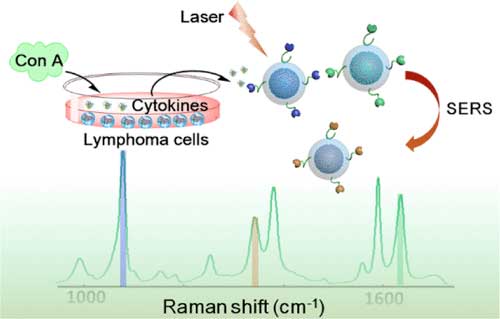| Sep 21, 2019 | |
New sensors could lead to earlier lymphoma diagnosis(Nanowerk News) Researchers at the Australian Research Council's Centre for Nanoscale Biophotonics have developed a new method of detecting multiple cytokines – the body’s messenger proteins – in very small volume samples, which could lead to earlier diagnosis of diseases such as lymphoma. |
|
| The work was published in a paper in the journal ACS Sensors ("Sensitive and Multiplexed SERS Nanotags for the Detection of Cytokines Secreted by Lymphoma"). | |
 |
|
| The newly designed SERS nanotags are composed of gold nanoparticles as the core, tuneable Raman molecules as the reporters, and a thin silver layer as the shell. Enhanced Raman signal is achieved due to a strong localization of light in the 0.2 nm thin, optically deep-subwavelength region between the Au core and the Ag shell. (© ACS Sensors) | |
| “It could open the door to non-invasive diagnosis at early stage, as well as clinical applications such as monitoring treatments,” says Dr Lianmei Jang, one of the authors of the study and a biomedical engineer based at Macquarie University in Sydney. | |
| Cytokines are a key part of the immune system which swing into action in the event of disease or injury. | |
| That has made them a longstanding target by researchers keen to get a better understanding of how the body responds to infection. | |
| It has always been a challenge, however, to simultaneously detect multiple cytokines in a single sample and this imposes significant limits on research. | |
| Various cytokines perform different functions and can trigger other cytokines to realist in a complex network speaking a complex “language”. | |
| “When you look at just one type of cytokine it is very difficult to tell what is going on between the cells,” Lianmei says. “If we can get to look at multiple cytokines we can understand better what is happening in the complex networks.” | |
| And being able to detect the cytokines in such low concentration – as low as 5 picograms per millilitre – allows for diagnosis at a very early stage, she says. | |
| Lianmei, working with Dr Yuling Wang’s team (AI of CNBP) developed the alternative detection approach using gold nanoparticles with surface-enhanced Raman spectroscopy (SERS) nanotags to target the cytokines used as biomarkers for lymphoma. | |
| Raman spectroscopy is widely used in chemistry to identify certain molecules. In this case the Raman readers on the nanoparticles picked up the signals from the cytokines. | |
| “The sensitivity of this technique that allows it to work in such low concentrations is down to the SERS nanoparticles,” says Lianmei. | |
| The project took around 18 months and was a collaboration with CNBP colleagues Ivan Maksymov and Andrew Greentree, based at RMIT in Melbourne. |
| Source: Australian Research Council | |
|
Subscribe to a free copy of one of our daily Nanowerk Newsletter Email Digests with a compilation of all of the day's news. |
